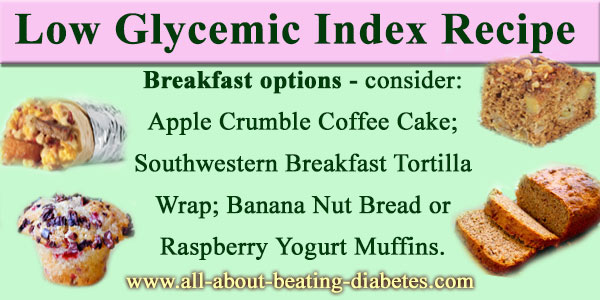Getting your low glycemic load foods tips
- Home
- Your Diabetic Information Center
- Low Glycemic Load Foods
The low glycemic load foods and low glycemic load concept in general is a little difficult to understand. Basically, nutritionists have developed it in order to assess all the known carbohydrates.
Low glycemic load foods are an essential component of a healthy diet, and they can help you maintain stable blood sugar levels and achieve overall good health. These foods are typically characterized by their low glycemic index (GI), which measures the impact of a particular food on blood sugar levels.
A low glycemic load diet is often recommended for people who are managing chronic conditions such as diabetes, heart disease, and obesity. These conditions can be exacerbated by a diet that is high in sugar and refined carbohydrates, which can cause spikes in blood sugar levels and lead to weight gain.
Low glycemic load foods, on the other hand, have a slower impact on blood sugar levels and provide a sustained source of energy throughout the day. They can help prevent energy crashes, reduce food cravings, and promote a healthy weight.
What are the low glycemic index foods?

Some of the best low glycemic load foods include whole grains, fruits, vegetables, lean proteins, and legumes. These foods are packed with nutrients, fiber, and protein, which can help keep you feeling full and satisfied throughout the day.
Whole grains, such as brown rice, quinoa, and whole wheat bread, are excellent sources of complex carbohydrates and fiber. These nutrients help slow down the absorption of sugar into the bloodstream, which can help prevent blood sugar spikes and crashes.
Fruits and vegetables are also great sources of fiber and low in sugar. Berries, apples, and pears are particularly low glycemic fruits that are also rich in antioxidants and vitamins. Leafy greens, such as spinach and kale, are also excellent low glycemic load foods that are packed with nutrients.
Lean proteins, such as chicken, turkey, and fish, are essential for maintaining muscle mass and promoting satiety. These foods are also low in fat and calories, which can help you maintain a healthy weight.
Legumes, such as beans and lentils, are excellent sources of plant-based protein, fiber, and complex carbohydrates. These foods can help regulate blood sugar levels and promote a healthy digestive system.
Implementing low glycemic index foods in your diet
- When incorporating low glycemic load foods into your diet, it's essential to focus on portion control and balance. While these foods can be beneficial for your health, consuming too much of any food can lead to weight gain and other health issues.
- One way to balance your diet is to incorporate a variety of low glycemic load foods into your meals. This can help you achieve a balanced intake of macronutrients and promote overall health.
- Another important aspect of a low glycemic load diet is to avoid or limit high glycemic load foods, such as refined carbohydrates, sugary drinks, and processed foods. These foods can cause blood sugar spikes and crashes and lead to weight gain and other health problems.
In conclusion, low glycemic load foods are an essential part of a healthy diet and can help you maintain stable blood sugar levels and achieve overall good health. By incorporating whole grains, fruits, vegetables, lean proteins, and legumes into your meals, you can enjoy a variety of nutritious and delicious foods that promote health and well-being. Remember to focus on portion control and balance and to avoid or limit high glycemic load foods to achieve optimal health.
Benefits from Low glycemic load foods:
- A better blood sugar level control.
- Lower risk for heart disease, cancer or diabetes or any other disease.
- You will lose the extra weight and will manage your weight easily.
- You will have more energy for daily activities.
- You will get a solution to any food craving.
- Your digestion will be better and you will feel much more comfortable.
It might seem difficult to follow and doubful diet, but after getting the right knowledge about glycemic load of foods, it will be easier for you to follow a low glycemic load diet and choose the right low glycemic load foods.
|
Written by Dr.Albana Greca Sejdini, Md, MMedSc Medically reviewed by Dr.Ruden Cakoni, MD, Endocrinologist |
Last reviewed 4/28/2023 |
References:
References:
- American Diabetes Association. Glycemic index and diabetes. Diabetes Care. 2004;27(7):1784-1785. doi:10.2337/diacare.27.7.1784
- Brand-Miller J, Hayne S, Petocz P, Colagiuri S. Low-glycemic index diets in the management of diabetes: a meta-analysis of randomized controlled trials. Diabetes Care. 2003 Aug;26(8):2261-7. doi: 10.2337/diacare.26.8.2261. PMID: 12882846.
- Jenkins DJ, Kendall CW, Augustin LS, et al. Glycemic index: overview of implications in health and disease. Am J Clin Nutr. 2002 Jul;76(1):266S-73S. doi: 10.1093/ajcn/76/1.266S. PMID: 12081850.
- Jenkins DJ, Wolever TM, Taylor RH, et al. Glycemic index of foods: a physiological basis for carbohydrate exchange. Am J Clin Nutr. 1981 Mar;34(3):362-6. doi: 10.1093/ajcn/34.3.362. PMID: 6259925.
- Ludwig DS. The glycemic index: physiological mechanisms relating to obesity, diabetes, and cardiovascular disease. JAMA. 2002 May 8;287(18):2414-23. doi: 10.1001/jama.287.18.2414. PMID: 11988062.
- Ma Y, Olendzki BC, Chiriboga DE, et al. Association between dietary carbohydrates and body weight. Am J Epidemiol. 2005 Nov 15; 162(10): 1115-25. doi: 10.1093/aje/kwi307.
- Thomas DE, Elliott EJ, Baur L. Low glycaemic index or low glycaemic load diets for overweight and obesity. Cochrane Database Syst Rev. 2007 Jul 18;(3):CD005105. doi: 10.1002/14651858.CD005105.pub2. PMID: 17636786.
- University of Sydney. Glycemic Index Foundation. Accessed April 28, 2023. https://www.gisymbol.com/
Diabetes complications Questions or Problems? Get Help Here
This is the place where you can ask a question about any aspect of diabetes complications.
It's free and it's easy to do. Just fill in the form below, then click on "Submit Your Question".